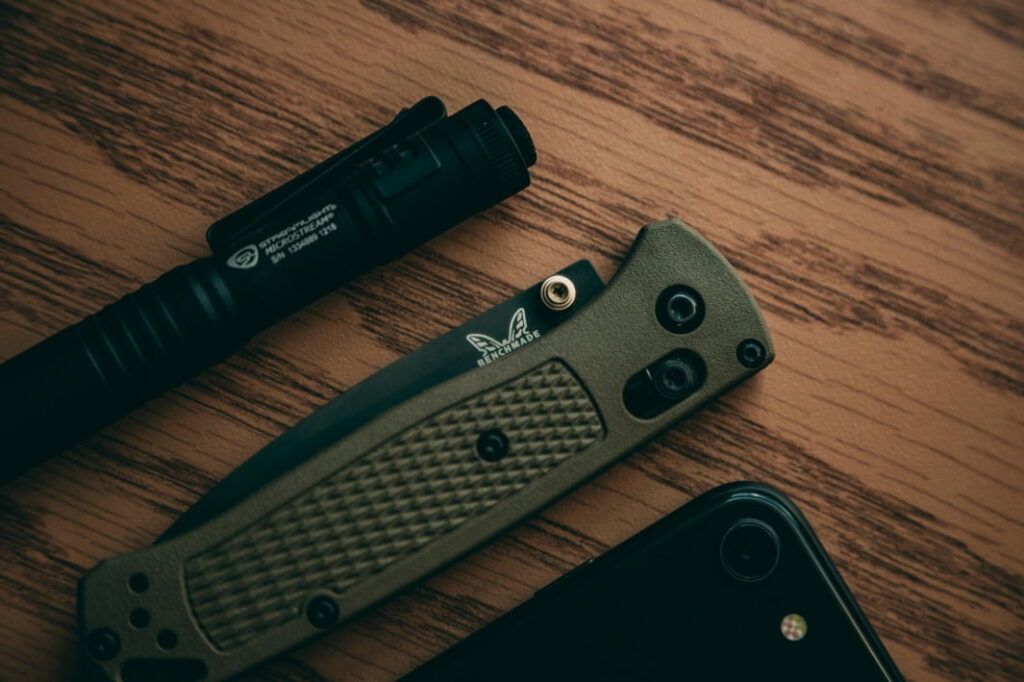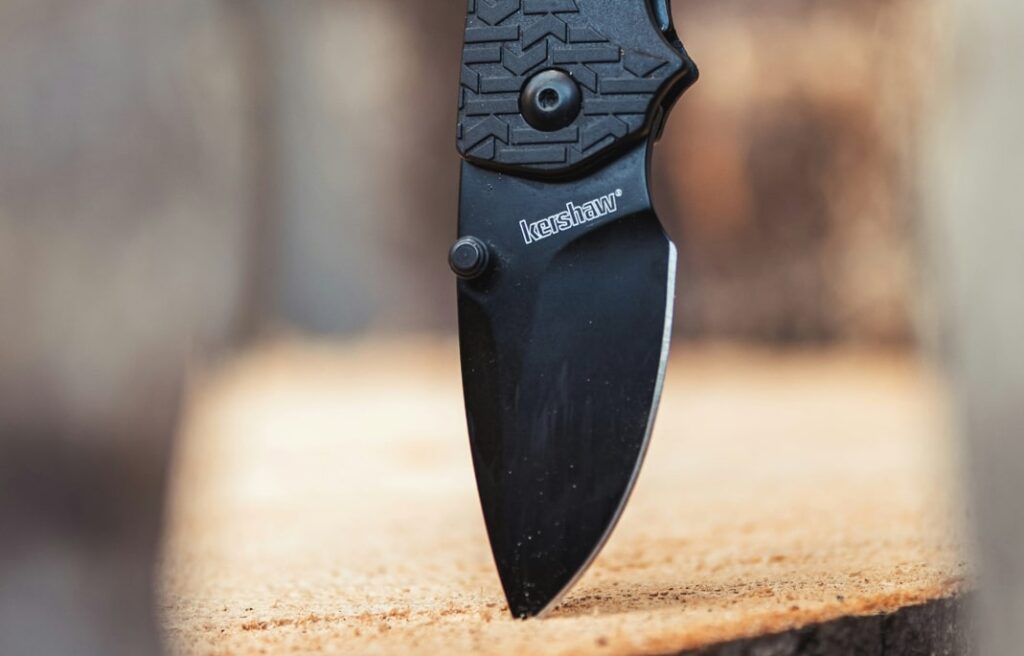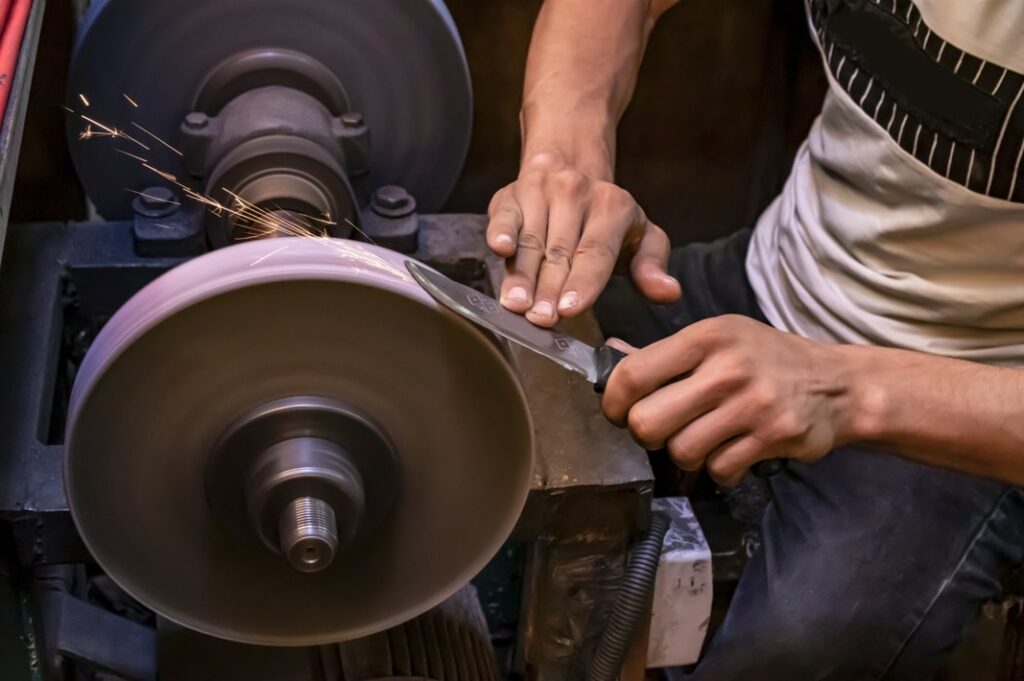The crossbar lock is a type of locking mechanism, perhaps better known as the ‘axis lock’ to those familiar with Benchmade knife models. This lock was developed by the renowned designers Bill McHenry and Jason Williams, who sold the concept to Benchmade in 1988. Benchmade then renamed the crossbar lock to ‘axis lock.’ The patent for this mechanism expired in 2018.
At its core, a crossbar lock functions by inserting a metal bar into a groove on the knife blade when it is opened. This secures the blade in place, preventing accidental closure during use. The mechanism is robust and ambidextrous, making it very popular among knife enthusiasts.
The appeal of crossbar lock knives extends beyond their safety features. They are also valued for their quick, one-handed operation, allowing users to deploy and retract the blade swiftly and securely. Continue reading to discover more about this unique locking mechanism.
Definition of crossbar lock knives

Crossbar lock knives are renowned for their innovative design that combines security with ease of use. This locking mechanism involves a metal bar that fits into a groove of the knife’s opened blade. The lock remains fixed during operation, thereby preventing accidental closure. Originating from a collaboration between designers Bill McHenry and Jason Williams. The crossbar lock gained significant popularity after being adopted and renamed as the Axis lock by Benchmade.
Since the patent’s expiration in 2018, the industry has seen a surge in variations of this mechanism, with many knife manufacturers introducing their own adaptations. These include the ‘ABLE lock’ from Hogue, the ‘Clutch lock’ from Kizer, among others. Each brand adds its own twist to the classic design, enhancing certain features or aesthetics to suit different needs. Due to the myriad of names and slight modifications, the knife community refers to these similar locking mechanisms collectively as the crossbar lock. This categorization simplifies discussions and helps in understanding the fundamental design shared by these locks.
Start Working with a Professional Now
Design and mechanics
The mechanism at the heart of a crossbar lock knife involves a spring-tensioned bar that moves back and forth across the knife’s tang. When you open the blade, the bar slides into a notch on the tang, creating a solid lockup that prevents the blade from closing unexpectedly. This design offers an ambidextrous and user-friendly experience. Materials like G-10 or aluminum often form the handle scales, contributing to the knife’s aesthetic and functional grip.
How to operate crossbar lock knives
To open
- Hold the knife handle in one hand.
- Use your thumb to manually flip the blade out or engage a thumb stud or flipper tab to initiate the opening.
- The bar automatically snaps into place on the tang, securing the blade.
To close
- Use your thumb to pull back the bar from the tang.
- Carefully fold the blade back into the handle until it’s fully retracted.
Familiarity with the pivot lock or ring lock may help you understand the crossbar mechanism, as they share similarities in operation.
Crossbar lock variations

The crossbar lock has many variations for the reasons we established earlier. Since the patent expired, multiple companies have designed their very own crossbar locks. Some of these variations significantly improve upon the original crossbar lock.
AXIS lock
The axis lock is the most well-known variation of the crossbar lock. Well, not a variation necessarily, Benchmade simply bought the right to manufacture the crossbar lock and renamed it to the axis lock. It is one of the most popular lock systems that functions the same with crossbar lock.
ABLE lock
Developed by Hogue, the ABLE lock offers a slight tweak compared to the original crossbar lock. While maintaining the essence of the crossbar mechanism, the ABLE lock introduces refinements that enhance its performance and user experience. With its modified design, the ABLE lock provides smoother operation and increased durability, ensuring reliable security in demanding situations. Renowned for its robustness and ease of use, the ABLE lock has garnered acclaim among knife enthusiasts and professionals alike.
DuraLock
Kershaw’s Duralock is nearly identical to the Crossbar or Axis lock in design and functionality. It shares the same fundamental principles of operation, providing reliable blade opening and ease of one-handed use.
Clutch lock
Sold by Kizer, the Clutch lock presents a distinctive variation of the original crossbar lock design. Unlike its predecessor, the Clutch lock offers enhanced adjustability, allowing users to fine-tune the tension according to their preference. This added flexibility ensures a personalized and comfortable experience, catering to the diverse needs of knife enthusiasts. With its intuitive design and customizable features, the Clutch lock exemplifies innovation in locking mechanisms, delivering both reliability and adaptability.
Crossbar lock vs other types of locks
When you’re comparing crossbar locks with other knife locks, it’s important to focus on their mechanisms and usability.
Crossbar locks, such as the renowned AXIS lock, employ a spring-tensioned bar that moves back and forth in a slot cut into both steel liners. Your manipulation of the bar—both to release and secure the blade—is what sets this lock type apart. The crossbar lock provides an ambidextrous design, offering ease of use for both right and left-handed individuals. It also tends to allow one-handed operation, which can be an advantage in various scenarios.

Liner lock
In contrast, liner locks involve a side spring bar located on the same side as the sharp edge of the blade, lock into place once the blade is fully opened. These are quite common and usually more affordable, but typically cater to right-handed use and might require two hands to safely close.
Frame lock
Frame locks are similar to liner locks but use a portion of the handle frame to lock the blade. The frame is cut to allow it to move sideways and lock the blade. This design is typically stronger than a liner lock and equally as easy to use, but it can be heavier and often more expensive.
Back lock
Then, there are back locks, which have a spine on the back of the handle that you must press to release the blade. This type of lock is strong but generally requires two hands to close safely, which can be a disadvantage in quick-use situations.
When choosing your knife, consider what locking mechanism best suits your needs in terms of strength, ease of use, and weight. The crossbar lock might offer the versatility you require, but other types might appeal to your budget or specific use-cases.
Start Working with a Professional Now
Advantages and disadvantages of crossbar locks
When you’re considering a knife with a crossbar lock mechanism, there are several factors to weigh in terms of functionality and design.
Advantages:
- Durability and strength: crossbar lock knife is built with an emphasis on resilience. The locking mechanism often involves a sturdy bar that passes through both liners, making it less likely to fail under stress.
- Ambidextrous use: You’ll appreciate the ambidextrous nature of the lock, as it is typically designed for easy operation whether you’re left or right-handed. This feature enhances its versatility and appeal to a wider audience.
- Safety: Safety is a priority, and crossbar locks allow you to close the blade without placing your fingers in its path, minimizing the risk of accidental closure during strenuous cutting tasks.
Disadvantages:
- Complexity: Although highly functional, the internal mechanism can be more complex than simpler lock types, which might become a consideration in field repair or maintenance situations.
- Price: If you’re budget-conscious, note that the intricacy of this lock design could lead to a higher price point compared to more straightforward locking systems.
Choose the best knife to kick-start your business
Crossbar is a classic, time-tested locking mechanism, offering plenty of variations to choose from. With the patent expired, manufacturers are free to produce and sell knives featuring this type of lock.
Collaborating with a reputable manufacturer with extensive experience in producing crossbar lock knives, as well as other knife types, can greatly benefit your business. Kegani is one such manufacturer. Contact us now to explore the opportunities we can offer! Whether it’s bulk purchasing, manufacturing, or OEM services, we are here to meet your needs.

